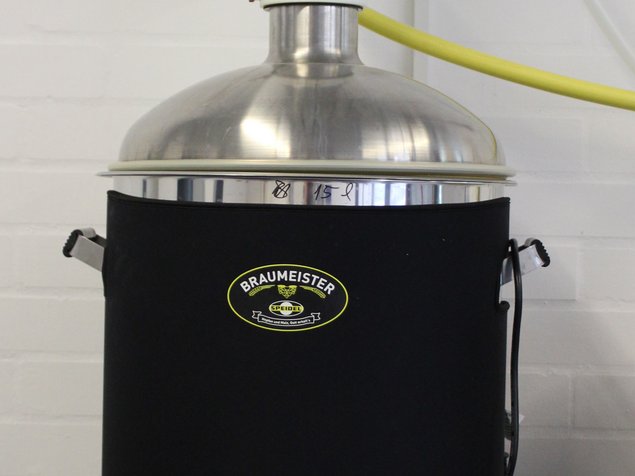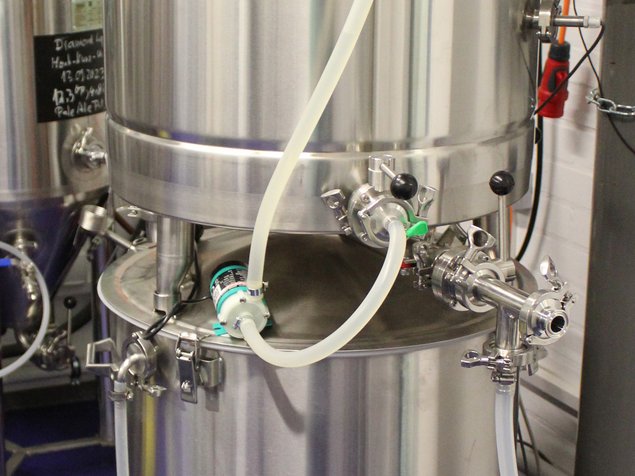In our brewery, we use systems with malt pipe technology as well as systems with a classic agitator. The systems with malt pipe technology are more compact and comparatively inexpensive, but in isothermal high-temperature mashing, systems with agitators have proven to be advantageous in terms of the subsequent alcohol content.
In a classic mash kettle, the malt mash is constantly stirred by an agitator until saccharification is complete, which is checked with the so-called iodine test. This ensures that perfect mixing takes place at all times and that the starch in the malt is optimally broken down. The mash is then pumped into a lauter tun, in which the wort with the dissolved components is separated from the solids.
Depending on the design of the system, the wort then flows into a third container, the so-called brew kettle, or back into the mash kettle, which then also functions as a brew kettle for boiling the brew. Boiling is necessary in order to release the bitter substances from the added hops and also to expel undesirable flavor carriers from the malt, such as dimethyl sulfide, which would otherwise give the beer an unpleasant vegetable-like taste.
In the malt pipe technique, only one vessel is required. The brewing pot has an inner malt pipe containing the malt. The wort is either pushed through the malt from below by a pump and then runs passively back down through the malt pipe at the top, or it is pumped from below through a pipe to the top, from where it runs passively back down through the malt.
At the end of the mashing program, the malt pipe is lifted and the wort runs into the container, the so-called spent grains remain in the malt pipe. In malt pipe systems, the mash kettle, the lauter tun and the brewing kettle are therefore located in one device. The largest commercial systems have a capacity of 1000 liters and are used in microbreweries and pub breweries worldwide.
We use the following devices and refer to the manufacturers for details of the equipment:
- Speidels Braumeister 10 L:
We have two of these machines, which we use to try out new processes or develop new recipes. As the name suggests, you can produce 10 liters of beer with this system. Speidels Braumeister 50 L:
This is a larger version that can produce 50 liters of beer with one brew.In the Braumeister series, the wort is pumped through the malt pipe from below
- Brew Monk 50:
We also have two of these devices, and they were the first two brewing systems we purchased. With the Brew Monk, the wort is pumped upwards through a pipe, from where it flows passively through the malt. One system can also produce 50 liters of beer, but due to the design and the somewhat more complex cleaning process, a little more time is required for brewing than with the Braumeister. - Brew Tools 150 pro:
This is a brewing system that can produce 150 liters of beer in one brew. The working principle is similar to the Brew Monk. Our personal record with this system is 4 hours from mashing to transferring the finished wort to the fermentation tank. - Danisbrewtower BT 140+:
The Brewtower is a compact system that combines a classic mash tun with agitator with aspects of malt pipe technology. Mashing takes place in the upper tank and the wort is pumped upwards from the heated area under the lauter floor using an auxiliary pump, resulting in good mixing and homogeneous temperature distribution. Lautering takes place in the lower container, where the wort can also be boiled. We use the Brewtower together with the Brew Tools 150 Pro in a three-device brewhouse and boil the wort in the Brew Tools system. The Brewtower requires a comparatively small footprint and is therefore also suitable for confined spaces.
In addition to these systems, we also have systems with agitators in the 25 L, 40 L and 60 L sizes. We use these for grain types for which the malt pipe technology is not quite as suitable, such as wheat beers, oat beers, rye beers or those based on quinoa, or simply for comparison with the malt pipe systems.



